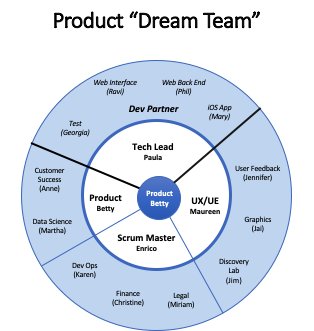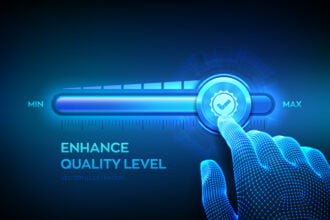Big data is leading to a number of major changes in businesses all over the world. One of the biggest changes to come from new advances in data analytics is an improvement in product development. We mentioned that insights made with big data can be important for developing digital products, but they can also be useful for creating physical products, too.
Data analytics technology is being used more and more by leading engineers all over the world. It can help create incredibly valuable products.
Data Analytics is the Key to Improving Product Development
We previously talked about using data analytics to promote products. As necessary as this is, big data can be even more important for developing products than marketing them.
Basketball fans of a certain age will remember the 1992 US Olympic team that included wall-to-wall legends including Michael Jordan, Magic Johnson, and Larry Bird. Nicknamed the Dream Team, their opponents in the Olympics lost by an average of nearly 44 points per game. Sports Illustrated called the Dream Team, ?arguably the most dominant squad ever assembled in any sport.?
Of course, this was before the advent of big data technology. Engineers and product architects around the world have since changed the concept of the Dream Team to accommodate this new technology. Some of them have made mistakes that they had to learn from to use data more effectively.
There are also dream teams in the game of developing new and exciting products with new AI and data analytics capabilities. Basketball?s Dream Team was about blowing opponents off the court by dozens of points, while winning gold medals. In the data-driven world today, the Dream Team is what we want on every project. In reality we find that even the most important, highest priority program struggles to find the right people at the right time. In other words, Dream Teams are often aspirational.
What is a Dream Team?
What is a dream team when it comes to product development in our technical world – whether it is delivering a cutting edge mobile solution or a mission critical IT program with the latest advances in data technology? It comes down to having the best people, who are right for the job in an environment where they can succeed. However, dream teams can be measured and characterized by their success. These measurements can be performed with remarkable new analytics platforms. A dev dream team is about (1) creating products that delight customers, while (2) realizing their true business potential. A true dream team also does this on the first try and with a minimum of drama.

It starts with the Product Lead. Think of this member of your dream team as a ?mini CEO,? with a C-Level skill set and capabilities. That means the Product Lead must have the ability to communicate a vision to both the team and to senior executives. The Product Lead must be the master of the project?s business plan. He or she must speak the language of the business and know how to excite passion in a team. The Product Lead also functions as the project?s feature editor, the one who sees the effort as a coherent whole, with the ability to subtract as many features as needed (but no more!), to realize the most elegant solution for customers. They may not be as technically savvy as other members of the team, but they still need to understand how to utilize the latest big data tools effectively.
This is usually someone with ten or more years of experience who has led successful data-driven product development efforts in the past, that have had a positive response from critics and in the marketplace, while also meeting broader business goals. It doesn?t hurt if this individual is telegenic, charismatic, and a good communicator.
Next comes the Tech Lead. In most modern tech companies, this is a full stack developer, a person who can lead the engineering of the user-visible portion of the product, the back end that interfaces with databases, and the commerce piece, while also developing the application for mobile devices. This expert should be especially knowledgeable about the latest insights in data technology.
Generally, the Tech Lead should have 10-15 years of experience, and possess broad technical skills. And the Tech Lead must also be able to direct the dev partner, step-by step, to realize the full potential of the product. The Tech Lead is someone who understands Agile methodology thoroughly, enjoying a technical background, as well as business savvy.
The third member of the dream team is the User Experience (U-Ex) guru. This individual is your design expert who develops the customer interface. This individual must have the ability to fulfill the Product Manager?s dream, by creating an elegant model that reduces the burden on consumers. This person leads Discovery, i.e. the efforts to turn customer information into spectacular products. While customers are never far from the minds of any dream team member, your U-Ex designer represents the customer on your team. On a truly superstar dream team, the U-Ex guru should have as many as ten years of experience in the field. They should use machine learning and other data analytics tools to create more effective tools.
Next comes the Project Manager or Scrum Master. This individual removes any obstacles in the way of the dream team?s success. Such obstacles may come in the form of awkward managers, onerous processes, or a lack of available resources. The Project Manager is the housekeeper who maintains order throughout the project. This individual runs the sprints and keeps management from meddling in the project unnecessarily. The Project Manager creates a protected space where innovation can thrive. This person may have five to ten years of experience in his or her field.
Extended Dream Team – Development Partner
Most importantly, a dream team must either have internal resources or an external partner. In our experience, many quickly scaling organizations have one or more superb Dev Partners. A solid Dev Partner is a trusted resource, technically experienced, with solid communication skills who has delivered for the organization in the past. They should be able to execute the product, as a virtual extension of an internal team, and build an MVP. Their role is to deliver high quality software while working reliably at a distance. Besides their track record of flawless execution, their most important additional skill is communication.
The Vision Matters, and So Does the User
However, a dream team is not just a set of highly skilled, qualified and experienced individuals. They also need to have certain qualities as a group. Even the biggest stars in the basketball galaxy won?t rack up lop-sided wins without all five players interacting effectively on the court. A dream team in the tech world must have a solid purpose, and they know their place within the product vision of the company. They need to understand their role in the strategy and the team?s charter must be crystal clear. This is the context in which your dream team can exercise its considerable talents.
Above all, the dev dream team must have an insight into a specific problem that users experience. They need to know it inside and out, and, as far as possible, experience the customer?s pain as their own. The team?s vision often takes the form of a solution to customer woes, but the real vision is to focus like a laser on what problem to solve. The dream team must also have a shared vision around the challenge they?re facing. It?s been said many times, but it remains true that in the best teams the sum is greater than the parts.
A Dream Team is Necessary, but Sufficient? No!
There are three additional factors that will spur your dream team to success: First, at least one person on the team should be a company founder or at least should have been with the company for some three to five years. You need at least one member who can ground the team in the culture of the company. Experience is a key factor for each member of the dream team. The project at hand cannot be the first rodeo for any member. Ideally all members of the dream team should have been through the dev process at least three times: one time they?ve watched it done; the second time they have done it; and the third time they have taught it or guided others to success.
Second, dream teams have to be funded. Budget must be set aside for the dev partner, for product launch, for marketing expenses, etc. One thing that will defeat a dream team is if they?re looking over their shoulders wondering where their next dollar is coming from.
Finally, the dream team must have a relationship with upper management characterized by trust. It is one thing for senior management to earmark the funding, but the actual, timely disbursement of funds is driven by trust that the team has the capability to deliver on the project?s promise — a product that the marketplace will accept because it meets an urgent need or want for end users.
The dream team described above is an ideal. Not every team, of course, can meet this high standard, but the description above provides a model for high performance teaming. This model can also remain consistent as the project scales. There may be only one Michael Jordan, only one 1992 Olympic basketball gold medal team, but every dev team can aspire to the goal of having a shared vision of excellence, with the skills, experience and savvy to bring superb tech products to market.
Sidebar
Checklist: Do you have these crucial elements of a dev dream team?
- Funding
o Is funding available for Discovery, for funding the dev partner, for product launch, for marketing expense, etc.?
- Charter
o Is the team?s charter clear, specific, and shared, and does it answer a pressing end-user need?
- Executive Alignment
o Has senior management bought into the team?s shared vision and are they prepared to fund the project at the necessary level?
- Process/Organizational Support
o Are functional heads alerted to what?s coming, and is their adequate funding resources of all types available to the dream team?
- Roles filled
o Do you have the Product Lead, Tech Lead and other roles filled, with all technical gaps identified and bridged?
- Right people in roles
o Do you have people in each role with the appropriate experience, skills, and knowledge?
- Plan for discovery
o Do you have a methodology and a plan for hearing the customer?s voice and bringing it into the dev process, so that customer needs are front-of-mind for the team?
Big Data is Crucial for Developing New Products
There are a lot of changes that have arisen from changes in big data. One of the biggest pertains to product development. Product developers need to be aware of these new developments and respond prudently.










